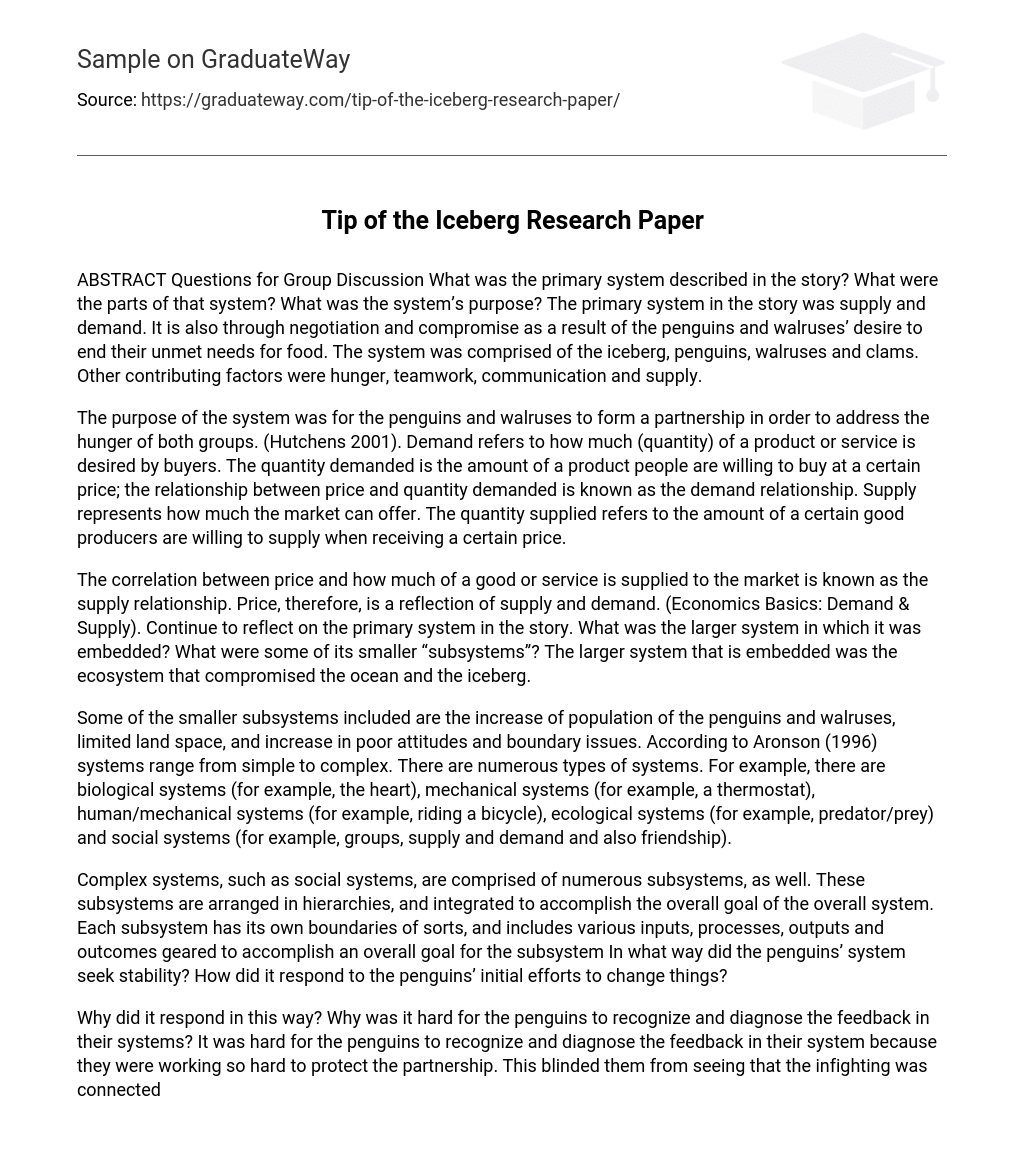ABSTRACT Questions for Group Discussion What was the primary system described in the story? What were the parts of that system? What was the system’s purpose? The primary system in the story was supply and demand. It is also through negotiation and compromise as a result of the penguins and walruses’ desire to end their unmet needs for food. The system was comprised of the iceberg, penguins, walruses and clams. Other contributing factors were hunger, teamwork, communication and supply.
The purpose of the system was for the penguins and walruses to form a partnership in order to address the hunger of both groups. (Hutchens 2001). Demand refers to how much (quantity) of a product or service is desired by buyers. The quantity demanded is the amount of a product people are willing to buy at a certain price; the relationship between price and quantity demanded is known as the demand relationship. Supply represents how much the market can offer. The quantity supplied refers to the amount of a certain good producers are willing to supply when receiving a certain price.
The correlation between price and how much of a good or service is supplied to the market is known as the supply relationship. Price, therefore, is a reflection of supply and demand. (Economics Basics: Demand & Supply). Continue to reflect on the primary system in the story. What was the larger system in which it was embedded? What were some of its smaller “subsystems”? The larger system that is embedded was the ecosystem that compromised the ocean and the iceberg.
Some of the smaller subsystems included are the increase of population of the penguins and walruses, limited land space, and increase in poor attitudes and boundary issues. According to Aronson (1996) systems range from simple to complex. There are numerous types of systems. For example, there are biological systems (for example, the heart), mechanical systems (for example, a thermostat), human/mechanical systems (for example, riding a bicycle), ecological systems (for example, predator/prey) and social systems (for example, groups, supply and demand and also friendship).
Complex systems, such as social systems, are comprised of numerous subsystems, as well. These subsystems are arranged in hierarchies, and integrated to accomplish the overall goal of the overall system. Each subsystem has its own boundaries of sorts, and includes various inputs, processes, outputs and outcomes geared to accomplish an overall goal for the subsystem In what way did the penguins’ system seek stability? How did it respond to the penguins’ initial efforts to change things?
Why did it respond in this way? Why was it hard for the penguins to recognize and diagnose the feedback in their systems? It was hard for the penguins to recognize and diagnose the feedback in their system because they were working so hard to protect the partnership. This blinded them from seeing that the infighting was connected to growing population in the iceberg. (Hutchens, 2001) There are various factors in an organization that deter it from responding appropriately to feedback.
According to Wilkerson (2003), leaders must involve all staff members in collaborative learning, discovery, and decision making if feedback is going to be consequential in an organization. At other times departments/functions operate independently and competitively. If an organization is divided into fragmented groups and functional teams exist independently of each other, knowledge is not shared throughout the organization. References 2009 from http://managementhelp. org/systems/systems. htm
Burchell, Noel, and Darl Kolb, Stability and Change for Substantiality, University of Auckland, Economics Basics: Demand and Supply. Retrieved October 31, 2009, from: http://www. investopedia. com/university/economics/economics3. asp Hutchens, D. (2001). The Tip of the Iceberg: Managing the Hidden Forces That Can Make or Break Your Organization. Waltham, MA: Pegasus Communications, Inc. Wilkerson, S. (2003). A monograph in creating organizational change using a living-systems approach. Retrieved October 25, 2009 from http://www. mcrel. org.





